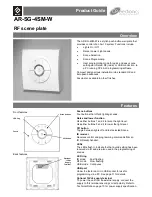
Introduction
CPC805
C P C 8 0 5 U s e r M a n u a l
22
© 2 0 1 2 F a s t w e l v . 0 0 1 a E P r e
Jumpers and External Buttons
List and functions of the onboard jumpers:
§
BIOS Setup parameters reset to default values (XP4);
§
LVDS power voltage selection: 5 V or 3.3 V (XP2);
§
PCI voltage selection: 5 V or 3.3 V (XP13);
§
The module’s power mode selection: unipolar or ATX (XP10);
§
Connection of terminators for RS-485: (XP18 and XP19);
§
PCI-E mode selector: four x1 or one x4) (XP23);
§
2-contact external Reset connector (XP9);
§
2-contact connector for “Power” button (XP8)
TFT Backlight and Power Control
§
TFT backlight control is realized via on-board 10-contact connector
§
TFT power voltage onboard selector
Thermal Management
CPU overtemperature protection is provided by:
§
Internal processor temperature control unit initiates CPU shut down
§
Processor frequency and cooling fan control conforms to ACPI specification
§
Processor die temperature monitor can report processor temperature to the user program
§
Custom designed heatsinks
Watchdog Timer
§
FPGA based programmable watchdog timer (on LPC bus)
LEDs
Four LEDs are located on the front side of the module:
Name
Function
Description
HL1 green
Startup diagnostics
Fast blinking (~8 Hz) after power-on,
slow blinking (~1 Hz) after BIOS is started until
INT 19h BIOS procedure is finished
then lights constantly.
HL1 red
IDE/SATA activity
On when IDE/SATA devices are accessed
HL2 green
HL2 red
User LEDs. Controlled through 317h register (see subsection SPI Controller Registers
description.
Gigabit Ethernet status (1 and 2) LEDs integrated in sockets:
§
Line: (green) Line connected
§
Act: (green) Network activity
RTC
§
Integrated in ICH8
§
Li battery backup
















































